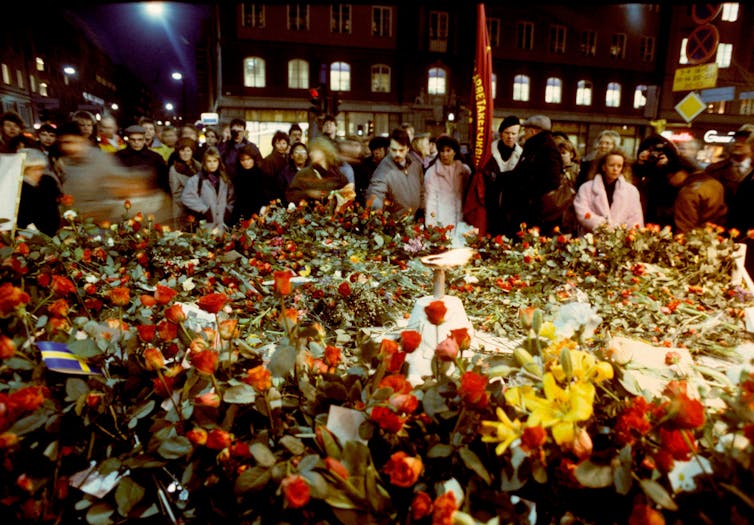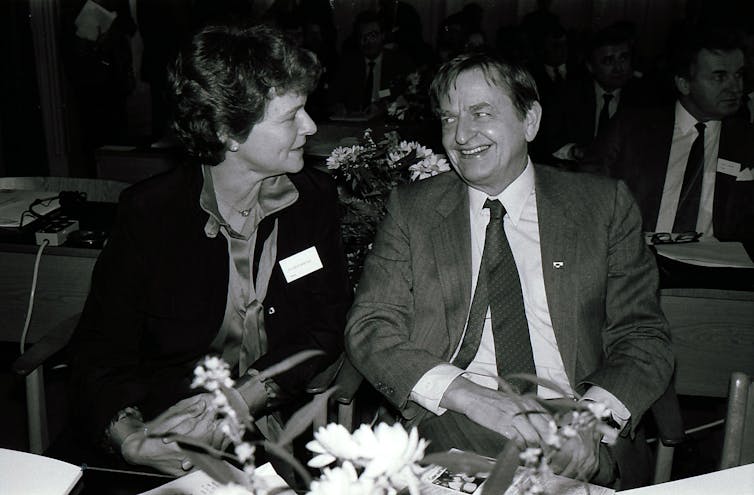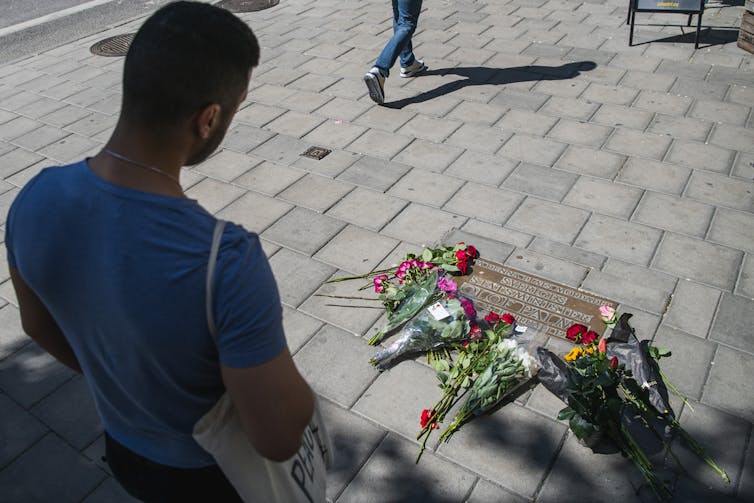Who killed Sweden's prime minister? 1986 assassination of Olof Palme is finally solved – maybe
- Written by Andrew Nestingen, Professor, Department of Scandinavian Studies, University of Washington
It took 34 years, 10,000 interviews and 134 murder confessions[1], but the assassination of Swedish Prime Minister Olof Palme has now been solved.
Palme was shot on the Stockholm street Sveavägen – roughly, “Mother Sweden Way” – in February 1986, after a night at the movies with his wife and son.
On June 10, 2020, chief state prosecutor Krister Petersson identified the killer as Stig Engström[2], an eyewitness dubbed “Skandia Man” during the initial murder investigation. However, no charges can be brought against Engström because he died in 2000, in an apparent suicide[3].
Engström is not the first person to be singled out or charged in Sweden’s most famous cold case. As I write in my book on crime fiction in Scandinavia[4], the Palme killing and bungled investigation represent a traumatic chapter in Sweden’s otherwise relatively peaceful history.
Botched investigation
In 1989 a man named Christer Pettersson was convicted of murdering Palme, leader of Sweden’s Social Democratic Party. Pettersson had a criminal past[5], including a manslaughter conviction[6], and Olof Palme’s wife Lisbeth identified him in a police lineup as the man who killed her husband.
But an appeals court later overturned the conviction because the prosecutor failed to present a murder weapon[7].
 The crime scene on Sveavägen street in central Stockholm, 1986.
Eif R. Jansson/TT News Agency/AFP via Getty Images[8]
The crime scene on Sveavägen street in central Stockholm, 1986.
Eif R. Jansson/TT News Agency/AFP via Getty Images[8]
Now Swedish authorities seem confident Engström is their man[9] – or moderately confident, at least.
Engström came forward to police in 1986 after Palme’s murder because he worked as a graphic designer for the Skandia Insurance Company, located near the crime scene. He claimed to be one of the first on the scene, and told police he tried to help resuscitate the prime minister.
But in their recent reexamination of interviews and other material, police found problems with Engström’s eyewitness story.
“No one saw anyone resembling Engström in the role he described himself playing[10],” said investigative lead Hans Melander in the press conference announcing the conclusion of the case. His story “doesn’t hang together.”
Engström was also a political opponent of Palme, who became prime minister in 1969. Palme had an aristocratic background and studied in the United States but became an outspoken socialist. His 15 years in office positioned Sweden as a “wealthy, advanced democracy that stood for equality, compassion and humanitarian values,” according to Jan Bondeson’s book “Murder on the Snow[11].”
Palme’s progressive vision and his opposition to the Vietnam War, apartheid South Africa and dictatorships worldwide created many enemies, including the right-wing Engström.
 Olof Palme four weeks before his death in 1986.
Francis Dean/Corbis via Getty Images[12]
Olof Palme four weeks before his death in 1986.
Francis Dean/Corbis via Getty Images[12]
In 1992, Engström turned up at the door of journalist Jan Arvidsson and spoke at length about Palme’s murder – just as he had done with police in 1986. In the press interview, Engström provided details about a possible murder weapon[13] and suggested Palme’s murder could be a crime of opportunity.
However, “I personally would have used a more versatile weapon, a smaller caliber,” he said, adding: “If I had been the murderer.”
‘We’ve come as far as we are able’
Despite the official closure of the Palme case, many Swedes have reservations[14].
The prosecutor, Petersson, presented no new or especially convincing evidence about why he believes Engström is the killer. The murder weapon remains missing, despite 738 weapons having been tested[15].
But, Petersson explained, “We’ve come as far as we are able to come when it comes to a suspect.”
Doubt has shadowed the Palme investigation, which was criticized for failures to seal the crime scene and flawed analysis of witness testimony. Petersson took over the “Palme Group” in 2016 – one of many changes in leadership – and brought in a new team to review the voluminous material yet again.
The case also received renewed attention, and possibly some useful new information[16], with the 2018 serial publication of journalist Thomas Pettersson’s “The Unlikely Murderer[17]” in the magazine Filter. Petersson, who is not related to the suspect Christer Pettersson, turned over his findings to the prosecution.
Olof Palme’s son Mårten acknowledged that errors marred the investigation of his father’s killing[18].
But, he said, “I believe the Skandia Man is guilty,” citing the compelling case presented in Filter magazine. “And I believe the case should be closed.”
 A memorial plaque where Swedish Prime Minister Olof Palme was murdered.
Jonathan Nackstrand/AFP via Getty Images[19]
A memorial plaque where Swedish Prime Minister Olof Palme was murdered.
Jonathan Nackstrand/AFP via Getty Images[19]
Closure
Solving the Palme killing may be an injection of good news for Sweden, which has suffered an exceptionally high death toll during the coronavirus pandemic[20].
Sweden, which has not fought a war since 1814, has avoided the historical traumas of its European neighbors and become a leader in advancing international peace and cooperation.
But the assassination of Palme, who represented these values, is one of several traumatic domestic events to shake the country. In 1973, a prolonged hostage crisis at a bank spawned the term “Stockholm syndrome[21].” In 2003, Foreign Minister Anna Lindh was murdered in a Stockholm department store.Swedes often speak of these events as a loss of innocence for the famously peaceful, trusting nation. In that sense, closing Palme’s case represents an ambivalent coming to terms with their modern history – a foothold of wisdom, perhaps, in a particularly difficult present.
“The shot on Sveavägen [Street] has been a crisis, a wound, a riddle without a solution,” said current Swedish Prime Minister Stefan Löfven[22]. “The murder of a prime minister is a national trauma. It’s my deepest hope that the wound can now begin to heal.”
[Deep knowledge, daily. Sign up for The Conversation’s newsletter[23].]
References
- ^ 134 murder confessions (polisen.se)
- ^ Stig Engström (www.svt.se)
- ^ apparent suicide (www.washingtonpost.com)
- ^ write in my book on crime fiction in Scandinavia (uwapress.uw.edu)
- ^ criminal past (www.thelocal.se)
- ^ a manslaughter conviction (murderpedia.org)
- ^ failed to present a murder weapon (www.cornellpress.cornell.edu)
- ^ Eif R. Jansson/TT News Agency/AFP via Getty Images (www.gettyimages.com)
- ^ confident Engström is their man (polisen.se)
- ^ playing (polisen.se)
- ^ Murder on the Snow (www.cornellpress.cornell.edu)
- ^ Francis Dean/Corbis via Getty Images (www.gettyimages.com)
- ^ murder weapon (www.aftonbladet.se)
- ^ many Swedes have reservations (www.dn.se)
- ^ despite 738 weapons having been tested (www.dn.se)
- ^ possibly some useful new information (www.nytimes.com)
- ^ The Unlikely Murderer (magasinetfilter.se)
- ^ investigation of his father’s killing (www.dn.se)
- ^ Jonathan Nackstrand/AFP via Getty Images (www.gettyimages.com)
- ^ exceptionally high death toll during the coronavirus pandemic (www.livescience.com)
- ^ Stockholm syndrome (www.bloomsbury.com)
- ^ said current Swedish Prime Minister Stefan Löfven (www.dn.se)
- ^ Sign up for The Conversation’s newsletter (theconversation.com)
Authors: Andrew Nestingen, Professor, Department of Scandinavian Studies, University of Washington

